Advertising, annoying as it is in the present, is a great tool for looking at the past. You really do get a sense for what passed as acceptable, who people thought the ideal consumer was, and what kind of life people dreamed they could have, when you look at the elaborate construction of fantasy and insecurity that plays out in the advertising medium. 1 This is one of the reasons it is especially galling, as an historian, that many digitized archives of past magazines or journals do not let you search advertising copy, or even — gasp! — have all advertising cut from them. This sort of thing is so irritating for historians, just passing that on.
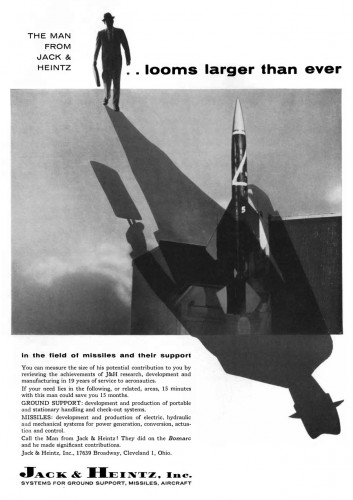
Jack and Heintz missile systems ad, August 1958. See what you’re missing if you cut out the ads? No comment necessary.
Scientific American is a periodical whose online archival incarnation thankfully retains the ads. You can’t search them through the default search engine, but they’re in the PDFs. By downloading lots of PDFs in bulk (it can be done), you can then run searches for specific ad copy across all of them, or compile the individual articles into massive PDFs that roughly approximate a full bound set. (There are some ways in which having digital sources are a convenience — instant searching! — and some ways in which it is a pain — difficult browsing.)
During the Cold War, Scientific American was a major periodical, much more so than it is today. Its publisher since 1948, Gerard Piel, was not a scientist, but saw himself as an ideal Cold War liberal intellectual lay science enthusiast. He was anti-nuclear weapons and pro-nuclear power, if that helps solidify the type. In the 1950s he was anti-McCarthy and pro-Oppenheimer, by the 1970s he was criticized as being too old for the New Left. When he took over Scientific American, it was still being pitched at industrial researchers and tinkerers; under his management, it became something of a luxury “lifestyle magazine,” where the lifestyle in question was science. 2
Of these early ads, the ones that really have gripped me in the past are the ones advertising for nuclear weapons scientists and for rocket scientists. They were advertisements that said — in fairly blunt language — that you’d be happier if you were making weapons of mass destruction. There’s something particularly American about that.
Without further ado, here are a few of my favorites, culled from issues of Scientific American from the 1950s:
How do you recruit a nuclear weapons designer? Los Alamos Scientific Laboratory tried a number of approaches. Some of these, like the one you see above from September 1956, emphasized that living out in the middle of nowhere could be “leisurely living,” and also emphasized the cool topics you’d get to work on: weapons physics, nuclear propulsion, etc. You’ve also got to admit that Los Alamos had a pretty cool logo at the time, as well. The “we work in an awesome place” pitch is one that Los Alamos would return to on a regular basis.
Los Alamos could also emphasize its history. It was over a decade old at this point, and had done some pretty important things. The above ad, from October 1956, has a wonderful message of “Los Alamos gets in the newspaper because it’s important” mixed in with an attempt to recruit young scientists.
Livermore, on the other hand, started out with a much more blunt approach: Got any new nuclear weapons ideas? Tying their work in with the work at Berkeley helped, of course — the Berkeley Rad Lab had at least as fabled a history as Los Alamos, and some of their later ads would do this even more explicitly.
To draw a contrast, take a look at this Sandia advertisement from May 1958. It’s more heady and ideological than the “come do science” and the “we have nice mountains” sorts of pitches:
For centuries men have tried to develop new and more powerful weapons to achieve victory in war. Lately these have been weapons of unprecedented power. Now war can become race suicide, and victory thus gained is a delusion. Yet we keep on trying to develop new and more powerful weapons, because we must. Not because we seek victory through a nuclear war, but because through strength we may prevent one. For as long as there are powerful forces with a record of cynical duplicity and oppression, the free world must have weapons capable of neutralizing them. At least until men learn that the only alternate to peace is oblivion. At Sandia, we play an important part in providing this protective strength…”
Although, for all of that rallying against “cynical duplicity and oppression,” a few months later (December 1958) a Sandia advertisement compared them to the Spanish Conquistadors — not exactly known for their peaceful ways. But lest you think this is the most politically incorrect form of scientist recruitment you might find from the period…
…Los Alamos had this one in the same issue. No comment here, other than the fact that this is obviously pre-Wen Ho Lee.
Los Alamos also had this wonderful little ad from April 1959, where the fact that they used obscure weapons-physics jargon was taken to show that they were on the cutting edge of science. It’s a rather clever advertising approach, you have to admit — taking what might otherwise be seen as a weakness and turning it into a strength. They didn’t use this tactic very often, though; other ads from this period had someone different messages, like “Scientists are people,” or “we do peaceful stuff, too.”
The gender stuff in some of these ads is incredible. This is an ad that ran a few times in 1958, recruiting for rocket scientists at the AC Spark Plug division of General Motors:
This is the Mrs. Behind the Missile… It takes a special kind of woman to be the wife of one of today’s missile men. … They know more about the problems of raising a family virtually alone than they do about the business of producing the missiles themselves. This advertisement is a tribute to the courage of such women, and to the very real contribution they are making to the development of a guided missile arsenal for this nation’s defense. … If you are such a woman, and your husband has engineering or scientific training which could make a contribution to this program, and is not a member of the armed forces, ask him to write — or write yourself — to the personnel section of AC in Milwaukee.
What’s most interesting to me about this one is that it, unlike most of the advertisements in Scientific American from this period, is written under the conceit that women are going to be reading the magazine. Most of the ads, it almost goes without saying, were pitched at white, scientifically-educated men. This one seems to be pitched at that guy’s wife. Which might seem progressive if it wasn’t a pitch for wives to sign their husbands up as rocket scientists so they could live a patriotic life in depressing isolation.
 Douglas Aircraft was also on board with the “rocket scientist’s lifestyle” pitch, though it’s interesting how much more chummy it seems for men than was the one for women. This is from April 1957; it’s amazing how many of these rocket scientist ads were just pre-Sputnik. Things got so much crazier after Sputnik that it’s hard to forget that people were already pretty hyped up about rockets.
Douglas Aircraft was also on board with the “rocket scientist’s lifestyle” pitch, though it’s interesting how much more chummy it seems for men than was the one for women. This is from April 1957; it’s amazing how many of these rocket scientist ads were just pre-Sputnik. Things got so much crazier after Sputnik that it’s hard to forget that people were already pretty hyped up about rockets.
Douglas also used the “our work is so awesome it’s secret” pitch as well. “Look at all the nuclear-tipped missiles we’ve made! Actually, half of them are still secret!” I also really like the line, “These are the projects that require engineers who are looking far beyond tomorrow.” An impressive sounding bit of nonsense, no?
In the 1960s, Los Alamos’ as got a little more unusual — emphasizing that there was culture out where they worked. I’m not sure too many other places took this approach, though Los Alamos did it quite a few times. These ads are one part recruitment — meant to appeal — and one part projection. How much is the above ad actually soliciting scientists, and how much is it trying to say, “did you know that Los Alamos men appreciate art?”
It’s a stark contrast from this sort of ad from Lockheed (October 1956), which makes it look like your non-science time there will be spent playing golf, tennis, or boating.
What to make of all of these? There are a lot of obvious — perhaps too obvious — observations here. Gender stuff. Lifestyle stuff. Technoscientific enthusiasm. You know. But what strikes me as most interesting here is that in some of these, there’s a bit of explicit rah-rah Cold War ideology, but mostly it is absent. Is this because ideology is messy, or because it could be taken for granted? That is, do you appeal to rad science and rad living conditions because you don’t want to turn off people who aren’t totally sold on WMDs, or do you assume that the only people who are going to apply have already made their peace with that idea? I don’t know — there’s only so much you can see on the surface of these ads, without delving into the processes of their creation, much less their success or failure. Still, as source materials, these sorts of ads are wonderful windows into the past — often as much or more so than the magazine content they abutted. And like all good windows into the past, they raise as many questions as they answer…
- There’s an obligatory Mad Men reference here, but I never got into the show so I’d probably bungle it. I’m more of a The Wire sort of guy when it comes to television shows, I’ve got to admit.[↩]
- Everything I know about Scientific American and Gerard Piel comes from an excellent senior thesis I had the good fortunate to be an adviser for while I was at Harvard: Emma Benintende, “Who was the Scientific American? Science, Identity, and Politics through the Lens of a Cold War Periodical” (Senior thesis, Department of History of Science, Harvard University, 2011).[↩]
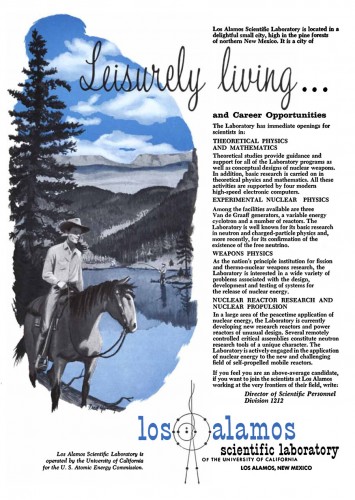
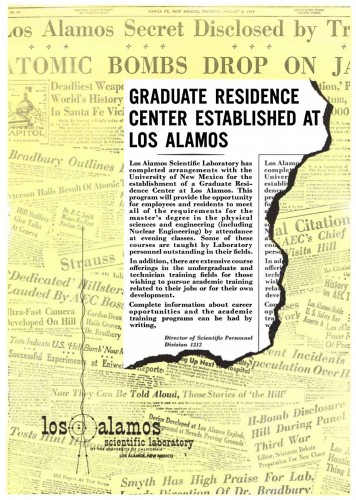
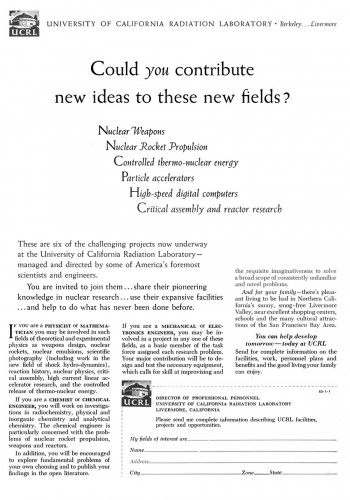
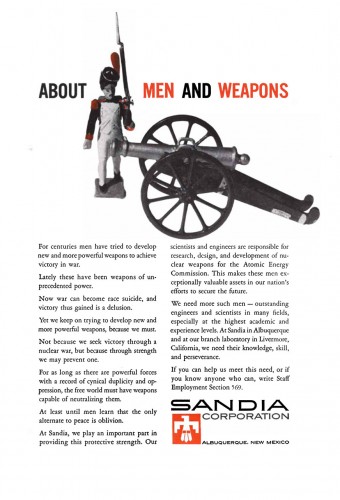

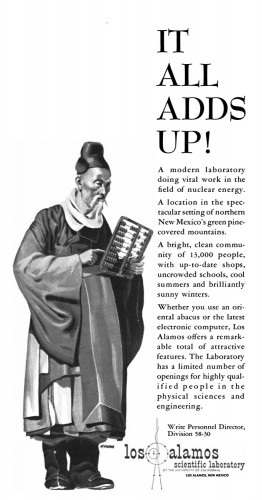
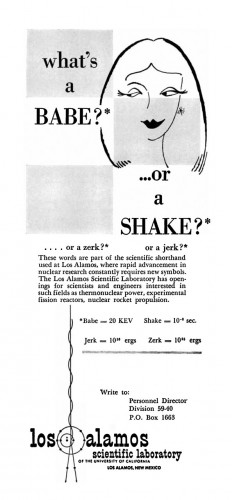

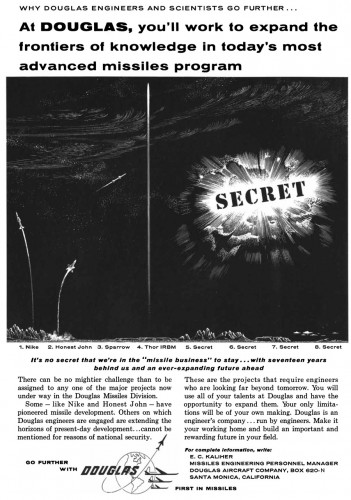
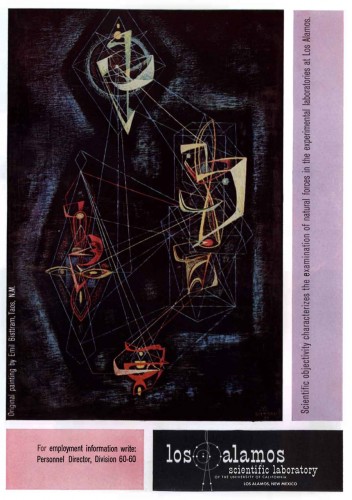
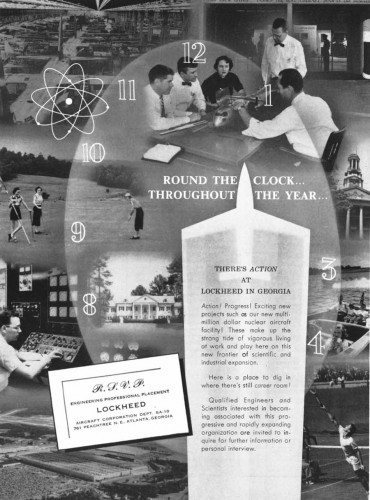


Alex-
Great piece; I looked at a lot of this sort of material when writing my Moonwatch book. Fascinating stuff. The Harvard thesis sounds interesting…do you have a copy available?
Patrick
I’ve sent one your direction. It’s a good thesis; I learned a lot from it, and it really helped me wrap my mind around shifts in the notion of what being a “Cold War scientist” really meant — everything from Herman Kahn to Linus Pauling and back again.
Alex, are you familiar with Jessica Wang’s American Science in an Age of Anxiety: Scientists, Anticommunism, & the Cold War (UNC Press, 1999), which surveyed this period as well?
Oh, of course. But it’s more of a late-1940s sort of coverage. What I have been struck by is how complicated the definition of the Cold War scientist gets once you get into the late 1950s and 1960s — once the idea of scientists as the new messiahs somewhat fades out.
Oh yes, while Security concerns remained strong. Indeed they were dominant, the “brick wall” I ran into. And this Security culture went sideways, into non-military areas. The IBM labs in San Jose 1969-70, Monterey Hwy end of Cottle Road, were extremely secure, high barbed wire fences, armed guards, as I recall . . .
Some of these appeared in Physics Today, but not the best ones, such as the ancient greek text about the 300, which implied that working at Sandia was like being one of the three hundred Spartans defending civilization against a horde of Persians.
That is, there are better ones in Physics Today.
There are some really wonderful Physics Today ads that I found a long time ago and were trying to hunt down again… Gunslingers, Spartans, etc. But alas, Physics Today’s electronic archive didn’t keep most of the ads, and we (shockingly) don’t keep back issues of Physics Today on file at AIP (they are stored offsite), so I couldn’t consult them. Ironically it was easier to look over those when I was back at Berkeley, when they were in the open stacks…
As it happens, this week I just purchased Megan Prelinger’s Another Science Fiction: Advertising the Space Race 1957-1962, a whole book of this sort of thing– I imagine you’re familiar with it.
Curating the Prelinger Archive, which included such magazines as Aviation Week and Missiles and Rockets (though it is better-known for its film collection), she became fascinated with the portrayal of spaceflight in advertising. I haven’t read much of it yet, but it looks great. And it likewise contains Los Alamos recruiting ads.
You know, I had known about this book — even looked at it at some point — and then somehow forgotten about it completely. Thanks for reminding me of it!
This would be a GREAT book.
There are some good ads here – http://www.howtobearetronaut.com/2011/11/rocket-ads-1947-1974/- though they’re more about contractors touting their weapons than about recruiting scientists.
Re fn. 1: If we believe Mad Man on the ad industry culture of the period, specifically the prevalence of juvenile pranksters within it, it really helps to explain all the phallic missiles!
Mad Men had an episode where they pitched for a defence contract and the power of an SLBM was mentioned in glowing terms, with Pete Campbell being visibly shocked, IIRC.
This is brilliant – thanks for publishing.
I have NEVER heard 20KeV called a “babe” before. That’s just silly.
Me neither. It’s included in the glossary of Robert Howard’s 1963 textbook, Nuclear Physics, though, for whatever it’s worth. There are a few others in there that I hadn’t seen before, too.
The “Leisurely Living” ad is eerily similar to, guess what, a picture of WWII Los Alamos physicists riding horseback in the mountains. I framegrabbed this photo of Robert Serber and Robert R. Wilson from Hugh Bradner’s home movies– about which I learned in reading this here blog.
Thanks Alex, heaps. I can relate strongly to what you write because I remember those days. I myself was extremely scared at the time, of nuclear war, effects thereof. Posters for a Hiroshima doco were being prominently displayed where I was living (in Launceston, Tasmania) during that period, and I vaguely recall seeing some/one of those ads, Scientific American being one of the mags that sucked me into Science as a schoolboy. My bus stop, was adjacent to the State Library Reading Room.
There are later associations also: I met a Sci Am writer when I was working at the IBM lab in San Jose 1970 (where Silicon Valley started). Most interestingly though:
Your article illuminates the world of “the top 15 US weapons labs” prior to DOE takeover during the Carter Administration, with subsequent decline of morale and security, supposedly, due to replacement of physicists in key administrative positions, by “anti-nuclear” environmentalists, “feminists” and so on . . .
I am sorry but, as usual for me, I understand what Alex is on about from “left field”. Inter-power rivalry, games and gamesmanship did not stop when the world went nuclear. It continued, only secretly ! ! !
Our Anglosphere is in decline compared to East Asia. Not its English language Internet and Science cultures, but its human and humanistic discourse, and so on. Hence what Alex is on about . . .
Alex’s article resonated strongly with me because, as a result of the above-mentioned and other early influences, I was sold on Atoms for Peace, and graduated into nuclear physics, worked in that field for years as well as other branches of Physics, and computers and so on.
I ran into a brick wall in my first attempts at nuclear physics jobs in Australia and Sweden largely because (as I found out later) both countries were seriously considering developing their own nuclear bombs at that time, 1966, an immense problem for me because my father’s influence (which was leftish) had been noted.
I was an excellent Physics Abstract researcher, so I became a good background observer of the nuclear arms race, nuclear gamesmanship and so on, years ahead of the MainStream Media (MSM) (academic articles started 1980).
I informed students ~1977, what was going on in that regard in central Australia. Busloads of students subsequently went there. These included the baby Julian Assange, with his mother.
My first social memories are of post-WW2 exuberance, but I learned wartime discipline because my friends were always older and remembered the war, and I was in a Boy’s Brass Band for 5 years and we played military music, saw veterans and so on, in 3 country towns on ANZAC day every year.
The past is well preserved in me because I have been living in Tasmania for 32 years, with roots here going back to the convicts. Tasmania is profoundly insular. Its population has been steady at ~1/2 million for ~100 years!
So what I see in those ads surprises me not at all. I simply see them as consistent with the nuclear gamesmanship I have been following for ~40 years. Post-Imperial ascendancy/descendancy is also involved, i e rise and fall of what has become of empires.
Makes you wonder why N. Korea, Israel and Iran, etc. haven’t thought to employ Madison Ave to help them recruit… 😉
My High school Chemistry teacher and her then late husband worked together at Los Alamos in the early 60’s. She was in her mid 30’s when I knew her, however she appeared to be about 65 or so. The apparent premature aging was caused by radiation exposure during the accident that killed her husband and probably doomed her to a foreshortened life.